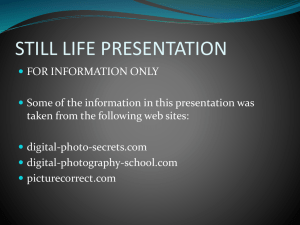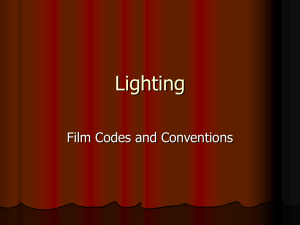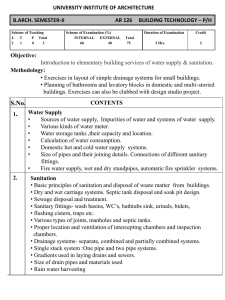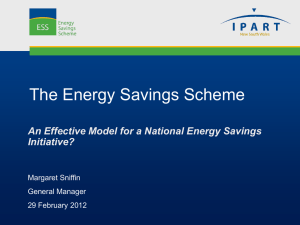Using the Commercial Lighting Formula and Calculation Tool478KB
advertisement
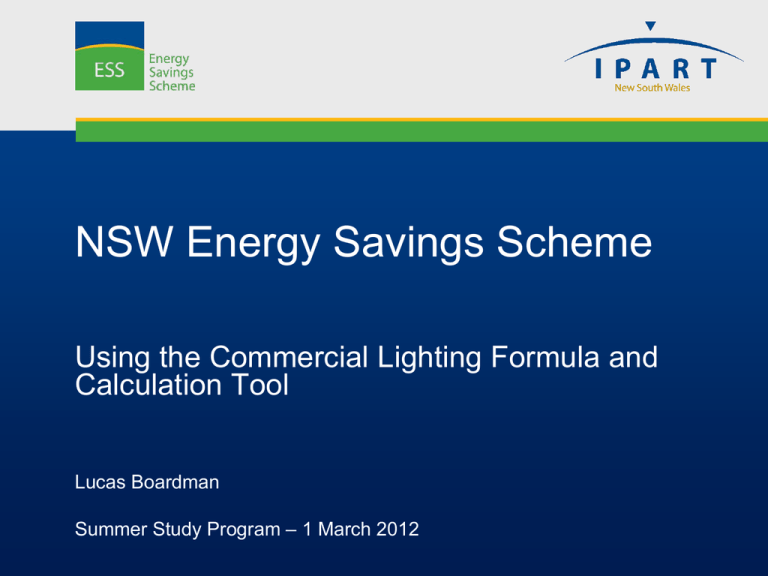
NSW Energy Savings Scheme Using the Commercial Lighting Formula and Calculation Tool Lucas Boardman Summer Study Program – 1 March 2012 Outline Energy Savings Scheme - Commercial Lighting Formula - Genesis Development of methodologies Key design aspects Commercial Lighting Calculation Tool Case study Experience to date Questions 2 2 Energy Savings Scheme – what is it? NSW mandatory scheme – established by legislation. Electricity retailers are the liable parties Started on 1 July 2009, legislated to 2020* Market based mechanism that involves the creation and trading of Energy Savings Certificates (ESCs) Companies are accredited for implementing projects which reduce electricity consumption Certificates currently trading at $25-30/ESC on a spot market. IPART – Scheme Administrator (certificate creation) and Scheme Regulator (compliance by liable parties) 3 3 Energy Savings Scheme - genesis Demand Side Abatement (DSA) Rule of NSW Greenhouse Gas Abatement Scheme (GGAS) spunoff to become the Energy Savings Scheme (ESS) GGAS DSA savings were 90% residential With ESS, one aim was to broaden the scope of energy savings activities 4 Energy Savings Scheme – development of methodologies Balance between activity specific factors & formulae vs more generic methodologies ex-ante (upfront deeming) vs ex-post certificate creation GGAS DSA experience – generic methodologies & ex-post certificate creation generated modest level of certificate creation ESS – increase in activity specific methodologies and more deeming than GGAS DSA - Commercial Lighting Formula is one of the new additions 5 5 Commercial Lighting Formula (CLF) – Key design aspects Broad coverage & flexible Adequate lighting outcomes Simplicity Accuracy 6 CLF – Coverage and flexibility Covers all types of commercial/industrial lighting upgrades (but not ‘greenfield’ lighting installations) Includes: – Commercial (industrial) building Lighting – Lighting of roads and public spaces – Traffic signals Covers ‘mainstream’ and ‘emerging’ lighting technologies (e.g. LEDs) Includes lighting controls (e.g. occupancy sensors) 7 CLF – Coverage - emerging lighting technologies – additional requirements (1) Emerging Technologies found in CLF Guide: LEDs (Lamps/Power Supply/Integrated Ballast) T5 adaptor kits Induction Lamps Voltage Reduction Units (VRUs) Meet requirements: Performance (LCP) – Test Report or Registered Information Electrical Safety – Fair Trading Electromagnetic Compatibility (EMC) – ACMA 8 CLF – Coverage - emerging lighting technologies – additional requirements (2) 9 CLF – Adequate lighting outcomes Minimum lighting design requirements – Exceed AS/NZS 1680 (where it applies) or other applicable benchmark – If part of a project subject to a development approval (DA), can only claim for savings exceeding DA requirements Customer engagement process Demonstration (example) project 10 CLF – Simplicity & Accuracy Energy savings calculated by comparing the ‘original’ and ‘upgraded lighting equipment, based on: Calculation Tool Lamp circuit power = Nominal lamp power + Power consumption of control gear (driver, ballast, transformer) Lighting controls (e.g. occupancy sensors) Air conditioning load Annual site operating hours (default of 3,000 hours) Asset lifetime (default of 10 years - buildings,12 years - roads & public spaces, except for ‘lamp only’ replacement) 11 CLF – Simplicity Calculation Tool 12 Calculation Tool: Benefits Ensures that the energy savings and number of certificates are done as per the ESS Rule. Simplifies administration of lighting upgrade projects. Generates a report to keep record of the lighting upgrades performed. 13 Case Study – manufacturing facility (1) Site-wide Lighting redesign involving various aspects, including Replacing 400W metal halide high bays & reactor ballasts with high efficiency 200W T5 fluorescent luminaires Lighting controls e.g. daylight linking, timers, occupancy sensors Permanent de-lamping in over-lit areas 14 Case Study – manufacturing facility (2) The financials Capital cost of $105,000 Reduced lighting power consumption by 66% Saving of 405MWh ($64,000) per year Payback of 20 months With participation in the ESS 4,293 ESCs (after application of deeming period) ESC revenue to site of over $75,000 Payback of 5 months! 15 CLF – Experience so far Experienced lighting operators vs new entrants Assessing emerging lighting technologies 29 companies accredited to date using CLF 32 different lighting activities Lighting upgrades at hundreds of sites throughout NSW 386,000 certificates created to date 16 www.ess.nsw.gov.au Thank You Independent Pricing and Regulatory Tribunal www.ipart.nsw.gov.au
